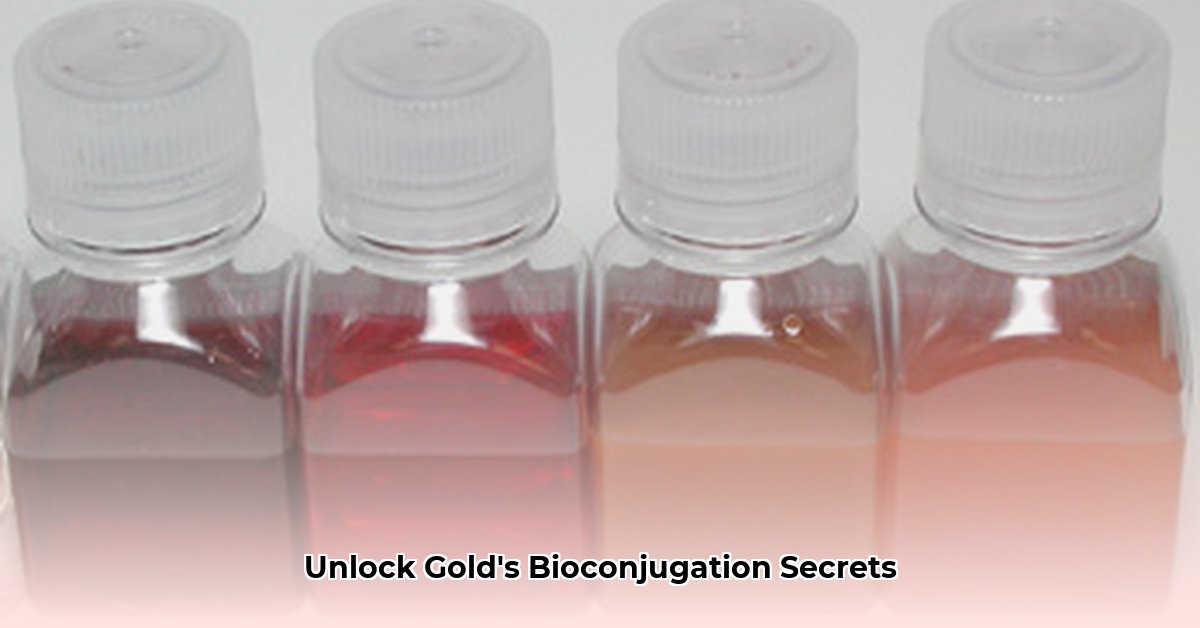
This instructional guide and review provides a comprehensive overview of gold sol selection, preparation, and bioconjugation for researchers and nanoparticle producers. We'll examine traditional and proprietary manufacturing methods, focusing on actionable intelligence to optimize your workflow and results.
Selecting and Preparing Your Gold Sol
The foundation of successful bioconjugation lies in selecting and preparing a high-quality gold sol. Key properties to consider include particle size, optical density, surface coating, and stability. Consistent particle size (e.g., within a narrow size distribution) is crucial for predictable bioconjugate formation, minimizing variability in your experiments. What is the optimal particle size for your specific application?
Particle Size and Size Distribution: Uniformity is paramount. A narrow size distribution reduces the variability of your bioconjugates' interactions. Targets can include specific sizes from 10 nm to 100 nm, depending on the intended application.
Optical Density: This reflects the concentration of gold nanoparticles. Accurate control over optical density ensures consistent experimental conditions and allows for precise stoichiometric control in your bioconjugation reactions. Naked Gold®, for example, boasts an optical density of 15 O.D./mL.
Surface Coating: The surface coating on your gold nanoparticles significantly affects their interaction with biomolecules. A thiol-modified surface is commonly used for conjugation with various biomolecules, due to the high affinity between sulfur and gold. What surface coating will best suit your chosen biomolecule and conjugation chemistry?
Stability: Long-term stability prevents particle aggregation, which is detrimental to bioconjugation efficiency. Longer shelf lives (e.g., two years as claimed by manufacturers like BioAssay Works for Naked Gold®) offer convenience and reduce the need for frequent sol preparation. How important is long-term stability to your project timeline?
Once selected, prepare your gold sol according to the manufacturer's instructions. This might involve dilution to the required optical density or other preparatory steps that maintain the suspension's stability. Improper handling can lead to agglomeration, rendering the sol unusable. Always conduct a quality assessment of the sol before proceeding to the bioconjugation steps.
Traditional vs. Proprietary Gold Sol Manufacturing
Traditional gold sol synthesis methods, such as citrate reduction, often yield polydisperse sols with variable particle sizes and morphologies. These inconsistencies directly impact bioconjugation outcomes, leading to reduced reproducibility and efficiency. However, modern proprietary methods offer increased control over nanoparticle properties.
Proprietary manufacturing processes frequently utilize more advanced techniques to achieve greater monodispersity, resulting in uniform particle size distributions. This control translates into higher efficiency and reproducibility in subsequent bioconjugation steps. Naked Gold®, for instance, offers a consistent 40 nm particle size, minimizing variability associated with traditional methods. While proprietary methods often come with a higher cost, the improved consistency and reduction in experimental variability can offset these costs, particularly in large-scale applications.
Performing Bioconjugation with Gold Sol: A Step-by-Step Guide
Bioconjugation involves a series of crucial steps:
Biomolecule Activation: Prepare your biomolecule (e.g., antibody, protein, DNA) by activating its functional groups to enable covalent bonding with the gold nanoparticles. Common activation strategies include EDC/NHS coupling chemistry.
Conjugation Reaction: Gently mix the activated biomolecule with the prepared gold sol under optimized conditions (pH, temperature, time) that maximize conjugation efficiency while minimizing nanoparticle aggregation. Thorough mixing is crucial to ensure uniform biomolecule distribution on the gold nanoparticles. What is the optimal reaction time and temperature for your specific conjugation chemistry?
Purification: Remove unbound biomolecules using techniques such as centrifugation, filtration, or dialysis. This step is essential to ensure purity of the resulting bioconjugates. Improper purification can lead to non-specific binding and erroneous results.
Characterization: Employ multiple characterization techniques (UV-Vis spectroscopy, Dynamic Light Scattering (DLS), Transmission Electron Microscopy (TEM)) to confirm efficient bioconjugation and assess conjugate quality. UV-Vis spectroscopy provides information on nanoparticle concentration, DLS measures particle size, and TEM provides high-resolution imaging of the bioconjugates, confirming successful conjugation and particle morphology. Are your characterization methods sufficient to meet the requirements of your application?
Characterization and Quality Control: Ensuring Reproducible Results
Rigorous characterization is paramount for ensuring the quality and reproducibility of your bioconjugates. This includes assessing:
- Particle Size Distribution: Confirming a narrow size distribution using DLS.
- Conjugation Efficiency: Quantifying the amount of biomolecule successfully conjugated to the gold nanoparticles.
- Stability of Bioconjugates: Assessing the stability of the bioconjugates over time and under various conditions.
- Bioactivity of Conjugates: Determining if the biomolecule maintains its activity after conjugation.
Actionable Intelligence for Stakeholders
Nanoparticle Producers: Focus on optimizing manufacturing processes to enhance control over particle size, shape, and surface functionality. Implement rigorous quality control measures to ensure consistent product quality and stability.
Bioconjugation Researchers: Standardize protocols, optimize reaction conditions, and carefully select gold sols based on the specific biomolecule and application. Utilize multiple characterization techniques to validate bioconjugation efficiency and conjugate quality. Consider the long-term stability of your bioconjugates under storage and application conditions.
Regulatory Agencies: Develop clear guidelines and establish standards for the production and application of gold sols in bioconjugation, ensuring safety and efficacy.
This guide provides a practical framework for successful bioconjugation using gold sols. Remember that diligent optimization of each step is essential for achieving reproducible and reliable results. The ever-evolving nature of nanotechnology demands continuous refinement of techniques and a commitment to rigorous quality control.